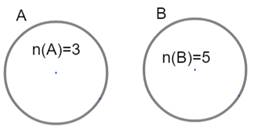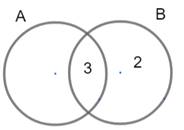If n(A) = 3 and n(B) = 5, find:
(i) The maximum number of elements in A ∪ B,
(ii) The minimum number of elements in A ∪ B.
Number of elements in set A n(A) = 3 and number of elements in set B n(B) = 5
The number of elements in A ∪ B is n(A ∪ B).
i) Now for elements in A ∪ B to be maximum, there should not be any intersection between both sets that is A and B both sets must be disjoint sets as shown.

Hence the number of elements in A ∪ B is n(A ∪ B) = n(A) + n(B)
⇒ n(A ∪ B) = 3 + 5
⇒ n(A ∪ B) = 8
Hence maximum number of elements in A ∪ B is 8
ii) Now for a number of elements in A ∪ B to be minimum, there should be an intersection between sets A and B so that some elements are common
The count will be minimum when all the elements from set A are also in set B the reverse are not possible because n(A) < n(B)
Hence if the 3 elements of A are in the intersection of A and B, then the number of elements only in B will be 2 because n(B) = 5
Visually it is represented as,

As seen from the figure the number of elements in A ∪ B is 5 hence minimum number of elements in A ∪ B = 5